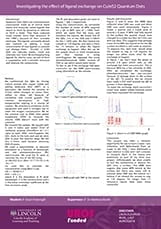By Ewan Pickersgill //
 QDs are semiconductor nanocrystals showing promise for optoelectronic, electronic, photovoltaic and biomedical applications because of their small size and the fact their band gap is dependent on their size and can therefore be controlled during manufacturing [1][2]. CID QDs are small, optically stable, can cause dispersion as a stable colloid and have a controllable photo luminescent emission from visible light to infrared [4]. CID QDs also have low toxicity making them more suitable for biomedical applications [4].
QDs are semiconductor nanocrystals showing promise for optoelectronic, electronic, photovoltaic and biomedical applications because of their small size and the fact their band gap is dependent on their size and can therefore be controlled during manufacturing [1][2]. CID QDs are small, optically stable, can cause dispersion as a stable colloid and have a controllable photo luminescent emission from visible light to infrared [4]. CID QDs also have low toxicity making them more suitable for biomedical applications [4].
This project aims to investigate ligand exchange from dodecane thiol (DDT) to mercaptopropionic acid (MPA) on (CID) Quantum dots (QDs). Exchanging longer ligands for shorter ones will shorten the interparticle spacing, improving conductivity by decreasing the distance the electrons have to ‘hop’ and allow us to form a superlattice with periodic structure.
To synthesise CID QDs, we mixed indium acetate with copper iodide, added DDT as a passivator and added octadecene (ODE) as a non-coordinating solvent (doesn’t react with solution) to increase the volume. We heated the solution to 210oC which turned it from a yellowy colour to deep red, indicating nucleation and growth of crystals in solution. The solution decomposes at high temperatures making it a source of sulphur. We used a condenser to stop solution loss to evaporation, and a nitrogen tap to lower oxygen concentration. We then let the solution cool to 60oC.
We cleaned the sample to get the QDs on their own. We initially used hexane but it isn’t miscible with ODE, so we used chloroform. We centrifuged the QDs 3 times in methanol, acetone, chloroform (in 1:2:1 ratio), this caused the QDs to stick to the tube, so we just poured the rest away. Each iteration removes approximately 90% of waste.
To test the properties of the QDs we performed photoluminescence (PL) spectroscopy and measured absorption as a function of wavelength us UV/visible light spectroscopy. Using this data, we calculated the concentration of QDs using Beer’s Law. From this we calculated the number of moles required for a 1:50 and 1:100 ratio of QDs to MPA and converted this to a mass by multiplying by the molar mass of MPA. We also added copper iodide in a 1:1 and 0:1 ratio with MPA to test the effects. We used chloroform and methanol separately as the solvent in every sample. Then we cleaned the sample as described above. We added water to the QDs, if the exchange was successful, the QDs will re-disperse in solution but that didn’t happen.
Unfortunately, due to work commitments I’ve been unable to finish my project in time. However, I intend to continue working. Over the next 10 days I will repeat the ligand exchange and re-test it. I’ll then use NMR spectroscopy to test what’s in our sample and the local structure, it will allow us to distinguish between ligands attached to the QDs and the ones free in solution. I’ll also deposit the sample onto a surface. I will submit the results when they’re finished.
I have thoroughly enjoyed this project. It has offered me the experience to work with a professional scientist, from which I’ve been able to learn about a topic I was unfamiliar with beforehand. Because of this I have a keen interest in QDs and I intend to study them further and potentially as part of my third-year project.
Bibliography
- https://www.sigmaaldrich.com/technical-documents/articles/materials-science/nanomaterials/quantum-dots.html [1].
- Molecular Ligands Control Superlattice Structure and Crystallite Orientation in Colloidal Quantum Dot Solids, Pralay K Santra, Axel F. Palmstrom, Christopher J. Tassone, and Stacey F. Bent, August 26 2016 [2].
- https://www.chemicool.com/definition/ligand.html [3]
- Determining the Concentration of CuInS2 Quantum Dots from the Size-Dependent Molar Extinction Coefficient Matthew Booth,† Andrew P. Brown,‡ Stephen D. Evans,† and Kevin Critchley*,† [4]
*To view Ewan’s project poster, please click on the thumbnail below:
